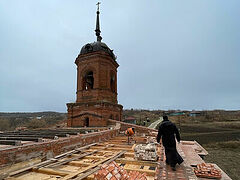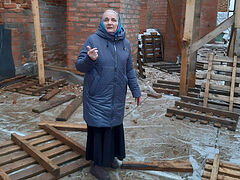 Sts. Peter and Paul Church in the Edelevo common
Sts. Peter and Paul Church in the Edelevo common
This majestic, Russian-style beauty of a church can be seen from afar. It invariably turns out well in photos with the plowed fields, emerald greenery or the fields of sunflowers as its backdrop. That’s why it is a favorite summertime photo location for those who enjoy picturesque abandoned sites. True, the Sts. Peter and Paul Church is partially destroyed these days and it is literally standing in the middle of nowhere. Its location is known today as Edelevo common. Not a settlement or a village—simply a common. What it means is that it has remained uninhabited for a long time...
On July 20, for the first time in almost a century, Divine Liturgy has been celebrated in the Sts. Peter and Paul Church. Metropolitan Longin of Simbirsk and Novospassk presided. Why do we serve in a dilapidated church, far from any, at least a desolate, settlement, where no one will most likely ever settle again? Perhaps, this is the question Vladyka hears most frequently these days.
 Sts. Peter and Paul Church in the Edelevo village in the beginning of the twentieth century
Sts. Peter and Paul Church in the Edelevo village in the beginning of the twentieth century
But let’s talk first about the history of the Sts. Peter and Paul Church, despite knowing only a few bits of it.
Prince A.P. Edelev founded the village of Edelevo around 1675 on the bank of Jerusalimka River. In 1729–1737, his son I.A. Edelev added a wooden church in honor of the Holy Apostles Peter and Paul and the village became known as Petropavlovskoye settlement, “also known as Edelevo,” and it was a part of the Buyinsky parish of the Simbirsk Governorate.
At the end of the nineteenth century, the wooden church burned down and, in 1895, it was replaced by a new stone church built according to the project by V.L. Ivanovsky, the architect from Simbirsk. It has survived miraculously to our days. The church had a priest and two psalmists. Beginning from 1863, Petropavlovskoye had a zemstvo school. In 1913, the village had one hundred twenty seven households and eight hundred eighty three inhabitants.
In 1922, a collective farm called “Perfection” was formed in the village. There was evidence of the attempts to destroy the church, but it has survived. We don’t know whether the collective farmers used it in one way or another, but there is no indication it was rebuilt or remodeled for economic needs. By the end of the 1960s and in the beginning of the 1970s, the collective farm had already fallen into a decline and Yedelevo was rated as a deserted village. It was incorporated into the neighboring village of Novye Maklaushi. Once the Edelevo school merged with the school there, Yedelevo was abandoned by its inhabitants. It happened in 1973. All that remained of the once large ancient village was the vacated Sts. Peter and Paul Church standing in the middle of the field, and its cemetery, practically as forsaken as the church...
The service in the ruined, abandoned church, according to its participants, brings both joy and sadness at the same time
A few days before the service, Orthodox volunteers cleaned up the temple and the surrounding area.
“The area around the church was overgrown with bushes and tall weeds. We also had to clean up everything inside. With the blessing of our Vladyka, I put the word out among our parishioners in Maina and we also invited the Orthodox youth from the metro area. About twenty people came. With God’s help, we were able to do some cleaning: we mowed the grass, cut down the trees and the bushes. It gave us minimal conditions to worship here,” says Rev.Fr. Arseniy Rozin, the dean of the Maina Deanery.
 Metropolitan Longin of Simbirsk and Novospassk
Metropolitan Longin of Simbirsk and Novospassk
On July 20, parishioners from the churches in Ulyanovsk and the workers’ settlement of Maina (nowadays, the Yedelevo common is a part of the Maina district), as well as residents of neighboring villages attended the service.
According to participants, the service in the ruined and abandoned temple brings both joy and sadness. But it is impossible to remain indifferent. Especially when special petitions have been offered “for the departed inhabitants of this place and everyone buried in this cemetery”—in other words, all those who used to reside in the abandoned village, who prayed and served in this church. After the Liturgy, a Paschal-rite procession walked around the church singing “Christ Is Risen!”
After the liturgy, a Paschal-rite procession walked around he church singing “Christ Is Risen!”
“This trip has become a truly significant undertaking for me,” says Svetlana Kochetkova, a resident of Ulyanovsk. “We arrived here as a three-generational family: my daughter, her husband and their children, and myself. We often travel to the holy places, but it is usually something that’s been fully restored, such as the Trinity-St. Sergius Lavra, Diveyevo, or our local Zhadovsky monastery… But when you come to a dilapidated church, it affects you differently. This is a general problem all over our country; unfortunately, we have many churches in such a state. How great it would be if they were alive again and prayers to our Lord Jesus Christ were lifted up there again...”
After the service, Metropolitan Longin addressed all those who had gathered at the Sts. Peter and Paul Church with prayer and hope for its revival:
“Every destroyed temple is every believer’s pain—mine as well—and it is a huge problem for the entire Russian Orthodox Church. The destruction of our people began precisely with the attempts to destroy faith and also with the destruction of the Church. In the 1920s and 1930s, almost all churches and monasteries were closed. The Bolsheviks declared entire regions godless and our Ulyanovsk region became one such region known as “The homeland of Ilyich.” People were told: “The popes intimidated and deceived you, but now we must close down all the churches, throw out the priests and monks—and what a life we’ll have!” And so they did as they said, closing down churches and kicking people out, and—what a life they had!... And so, we have lived to the point that we see empty villages today. But the village is the root of the nation. People living on their land and working as farmers are literally the original population of any country.
I would very much like to see all the abandoned and destroyed temples restored. Including this beautiful Sts. Peter and Paul Church! Common sense tells me: “But who will come here?” After all, no one lives nearby, and the nearest village is four kilometers away... But if the church still stands here, if it survived all the vicissitudes of the twentieth century—it means that there is the will of God to protect it, and someone needs it. I believe this.
We must keep in mind that temples were built to pray to God. It is alive because of worship there. So, if we hold services there, it means that, despite everything, despite all the damage that time and people have done to it, despite desecration and the lack of regular worshippers—the life in this church continues. I want it to stay alive. That is why I come to serve here, and I want to serve in all such churches in our region where it is possible to conduct services.
In many cases, it is practically impossible to completely restore the historical, ruined churches. But we will make an effort to keep them from decay and stop further destruction.
I want to believe that not only churches are preserved and restored, but also that the human hearts could undergo change so that people find their way to God
Please, brothers and sisters, pray that the Lord sends us caring people whose hearts would be aflame with pain and sorrow for the desecrated shrines of our people. I beseech your prayers to the Lord that He send laborers to His field. I would really like to see that not only churches are preserved and restored, but also that human hearts undergo change and our people return to God. It is not shameful or scary. If every person’s life and the life of our society were rooted in faith in God, we would live differently. Let’s love our Motherland and honor our parents, and may the parents take care of their children. Let’s do all the good that makes a man a man, a nation a nation. Pray to God that this come true!”








